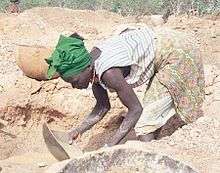Mining industry of Guinea

The mining industry of Guinea was developed during colonial rule, resulting in the improvement of the economic situation in the country. The minerals extracted consisted of iron, gold, diamond, and bauxite.[1] Guinea ranks first in the world in bauxite reserves and 6th in the extraction of high-grade bauxite, the aluminium ore.[2][3][4] The country accounts for 94% of Africa’s mining of bauxite.[5] The large mineral reserve, which has mostly remained untapped, is of immense interest for international firms.[6]
History
The mining tradition of Guinea is ancient and is traced to a period before the Middle Ages, when gold and salt were trading commodities between Guinea and Ghana. Following the independence of Guinea from colonial rule, the economy of the country was largely dependent on the mining industry, in spite of political turmoil racking the country since 2011.[1][4] Revision of the 1986 Mining Code was done in 1995.[5]
Production and impact
Guinea's bauxite reserve is 7.4 billion metric tons, which is 26.4 percent of global reserves.[2] High-grade iron ore reserves account for more than 4 billion tonnes. Diamond and gold deposits, as well as uranium, have also been reported.[3] The mineral industry has provided job opportunities to 10,000 people. In the export sector, mining has contributed to as high as 90% in earnings from foreign exchange. It now ranks sixth in global standing in the production of bauxite.[1] Despite holding large mineral resources, Guinea, with 9,000,000 people, has a low income level, with the average wage less than one dollar a day.[7]
There are two dozen international companies associated with mining operations in Guinea. The domestic agencies involved with mining are the Association pour la recherche et l'Exploitation du Diamant et de l'Or, Friguia Sal, Siguri Gold Property, and Societe AMIG Mining International SARL.[8]
Commodities
Minerals extracted in the country by private-public joint enterprises in collaboration with the Government of Guinea include bauxite, iron ore, and diamond. Other resources mined are cement, gold, salt, graphite, limestone, manganese, nickel, and uranium.[9] A major developer in the field of bauxite mining is the Alumina Company of Guinea (ACG-Fria), which is located in Fria; the Government of Guinea holds a 49% share while the Reynolds Metals Company holds the 51% balance in this enterprise.[10] Another partner in bauxite mining is Cie des Bauxites de Guinée's (CBG). It is a joint venture of Alcoa, Rio Tinto, and Dado Mining holding a 51% share, and the Guinean government holding a 49% share. Its exports of bauxite are the largest in the world, reportedly in excess of 13.5 million tonnes in 2008.[11]
Guinea has large reserves of iron ore, which have high potential for extraction. This largely remains untapped, and its quality grade is more than 60%. Rio Tinto's joint sector enterprise in the iron ore sector is the Simandou mine project, with a value estimated at $6 billion.[3][12] In 2012, Simandou mine was projected to produce 90 million tons of iron ore annually.[13] The Mount Nimba mine, also in the iron ore sector, is located in the Nzérékoré Region,[14] while the Kalia mine is in the Faranah Region.[14]
Diamond potential is estimated at 40 million carats. In 2012, production was 266,800 carats as per the Kimberley Process Certification Scheme, and it is listed as the 13th largest producer.[15]
A large number of gold mines are located in northeastern Guinea; the estimated production in 2011 was 15,695 kilograms.[15] One of the country's largest gold mines is the Lefa in Faranah Region.[16]
References
- 1 2 3 Soumah 2009, p. 11.
- 1 2 KPMG Global Mining Institute 2014, p. 18.
- 1 2 3 Reuters (1 November 2005). "One dead in Guinea protest, mine trains stop". Mines and Communities. Retrieved 25 May 2015.
- 1 2 KPMG Global Mining Institute 2014, p. 2-3.
- 1 2 "Mining in Guinea-Overview". mbendi.com. Retrieved 25 May 2015.
- ↑ KPMG Global Mining Institute 2014, p. 17.
- ↑ Agence France-Presse (1 November 2008). "Protesters block key mineral supply track in Guinea". Mines and Communities. Retrieved 1 September 2015.
- ↑ KPMG Global Mining Institute 2014, p. 23.
- ↑ KPMG Global Mining Institute 2014, p. 12.
- ↑ "Update 1-Glitch halts Guinea's CBG bauxite exports-sources". Reuters. Retrieved 25 May 2015.
- ↑ KPMG Global Mining Institute 2014, p. 2.
- ↑ KPMG Global Mining Institute 2014, p. 3.
- 1 2 "Tata suspends work on Mt Nimba". minesandcommunities.org. 2010.
- 1 2 KPMG Global Mining Institute 2014, p. 19.
- ↑ "Lefa Gold Project". nordgold.com. 2013.
Bibliography
- KPMG Global Mining Institute (2014). "Guinea: Country Mining Guide" (pdf). Strategy Series. KPMG International. Retrieved 25 May 2015.
- Soumah, Ibrahima (1 January 2009). The future of Mining Industry in Guinea. Editions L'Harmattan. ISBN 978-2-296-21573-3.